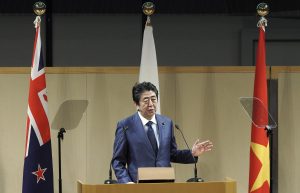Prime Minister Abe Shinzo is stepping down for health reasons. Having won a resounding victory in the December 2012 general election, regaining power from the former Democratic Party of Japan (DPJ) and returning as prime minister after five years, Abe emphasized foreign policy throughout his second tenure. He made a particularly strong impression with his active role in not only traditional bilateral diplomacy, but also in policies and negotiations meant to deepen multilateral coordination and cooperation. Examples include his efforts to strengthen the liberal international economic order through the Trans-Pacific Partnership (TPP) and Regional Comprehensive Economic Partnership (RCEP) negotiations as well as the advocacy of a free and open Indo-Pacific (FOIP).
The Abe administration’s TPP policy has been characterized by an obvious tendency toward flexibility and initiative-taking, combined with a degree of foresight. Part of the Japanese government had been discussing joining the TPP negotiations since around 2007, but it was kept off the policy agenda due to concerns about opposition from the domestic agricultural sector and other quarters. It was not until October 2010 that the Japanese government announced that it was considering joining the TPP negotiations, during the administration of Hatoyama Yukio of the DPJ. At the time, the Liberal Democratic Party (LDP) was opposed to the idea.
However, as soon as Abe formed his administration, he swiftly changed direction. He then suppressed strong domestic skepticism and opposition, joined the negotiations in July 2013, and ultimately played a leading role in promoting them. In 2017, when Donald Trump withdrew the United States from the TPP, the negotiations were at risk. Japan’s response was to coordinate negotiations among the remaining 11 countries, making important contributions to the eventual creation of the Comprehensive and Progressive Agreement for Trans-Pacific Partnership, while encouraging the United States to come back
As with the TPP, the Abe administration’s “FOIP” diplomacy also favored flexibility and initiative-taking, combined with foresight. From the time of his first administration, Abe spoke of “a broader Asia” and presented a foreign policy based on the “Indo-Pacific” concept, which essentially includes the area from the Indian to the Pacific Ocean. More or less at the time he took office again in late 2012, an Abe article was published on the website of the international NPO Project Syndicate. The “Asia’s Democratic Security Diamond” concept that he advocated in his piece was an argument for the formation of a “diamond” to safeguard the “common good” in a maritime area from the Indian Ocean to the Western Pacific through cooperation between Japan, Australia, India, and the United States. Since the plan was too obviously an effort to contain China, which at the time was rapidly advancing into the East China Sea, the South China Sea, and the Indian Ocean, the Abe administration did not subsequently promote it publicly.
Nonetheless, China under Xi Jinping accelerated its maritime advance and developed a number of policies designed to change the regional order, such as the advocacy of the Belt and Road Initiative and the founding of the Asian Infrastructure Investment Bank. In response to these Chinese initiatives, the Abe administration proposed FOIP as a regional vision from Japan. FOIP inherited the drive toward containing China from the Security Diamond while also signifying a major shift in Japanese regional policy by explicitly broadening the definition of the “Asia Pacific” to extend to the Indian Ocean as the “region” in which Japan should directly contribute to maintaining order.
The problem is that diplomacy requires counterparts and does not necessarily go in the direction you originally had in mind. Over the course of the eight years of the Abe administration, Abe’s diplomacy faced the bottleneck of two great powers determining the regional environment around Japan, as U.S. and Chinese foreign policies changed and their relations took a major turn for the worse. The aforementioned withdrawal from TPP by the Trump administration was a blow to the Abe administration, as they it has been working with the U.S. to advance the negotiations. China’s influence has also grown and the feasibility of any simple restraint or containment policy has rapidly diminished in recent years.
Another big factor was the wariness of ASEAN, which had expected to “share strategic interests and values with Japan,” of FOIP’s latent orientation toward containing China. The Abe administration also gradually reached the point of having to take China into consideration and FOIP became less concerned with restraining China, and more with exploring the possibility of Japan-China Cooperation on Third Countries, thus taking the regional order vision of the Abe administration in a rather different direction that originally planned.
At present, amid rising tensions between the U.S. and China, Japan is torn between the conflicting demands of taking on China together with the U.S. and prioritizing cooperation.
In other words, even the Abe administration, which sought to display leadership through a flexibility designed to quickly seize opportunities, was not able to halt the changes that have been making the regional environment around Japan more challenging.
This in turn is a reflection of the decrease in Japan’s relative political and economic influence in the region. As the economic and social dynamism of not only China but also other ASEAN countries grows, Japanese GDP growth has fallen short of the expectations of Abenomics and it is hard to claim that the Japanese economy has recovered its dynamism in any real sense. Even before COVID-19, the economy was weakening, and the pandemic will place further strain on already fragile public finances.
Abe’s successor will face a number of difficult issues: a regional environment increasingly complicated by the conflict between the U.S. and China, the relative decline in Japanese influence, and the shock from COVID-19. Japan will increasingly have to seek influence through multilateral diplomacy and regional and global institutions. It is this recognition that should inform the foreign policy of the next administration.
Mie OBA is a professor at the Graduate School of Law, Kanagawa University.

































